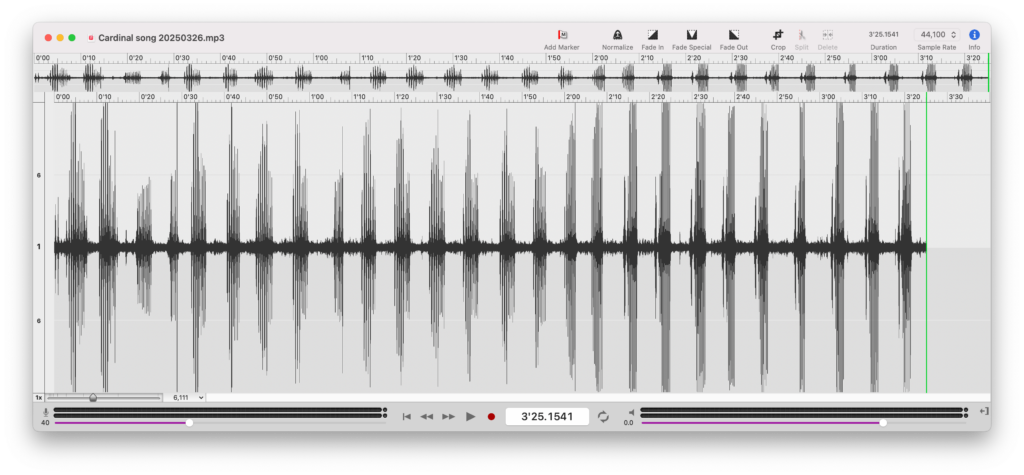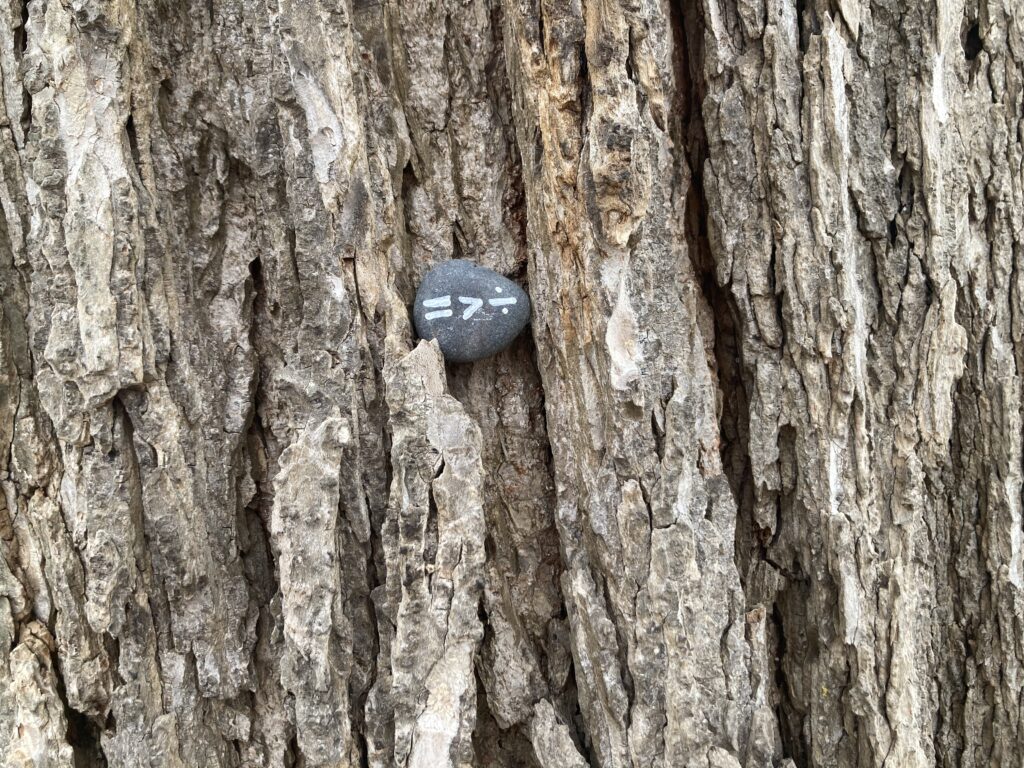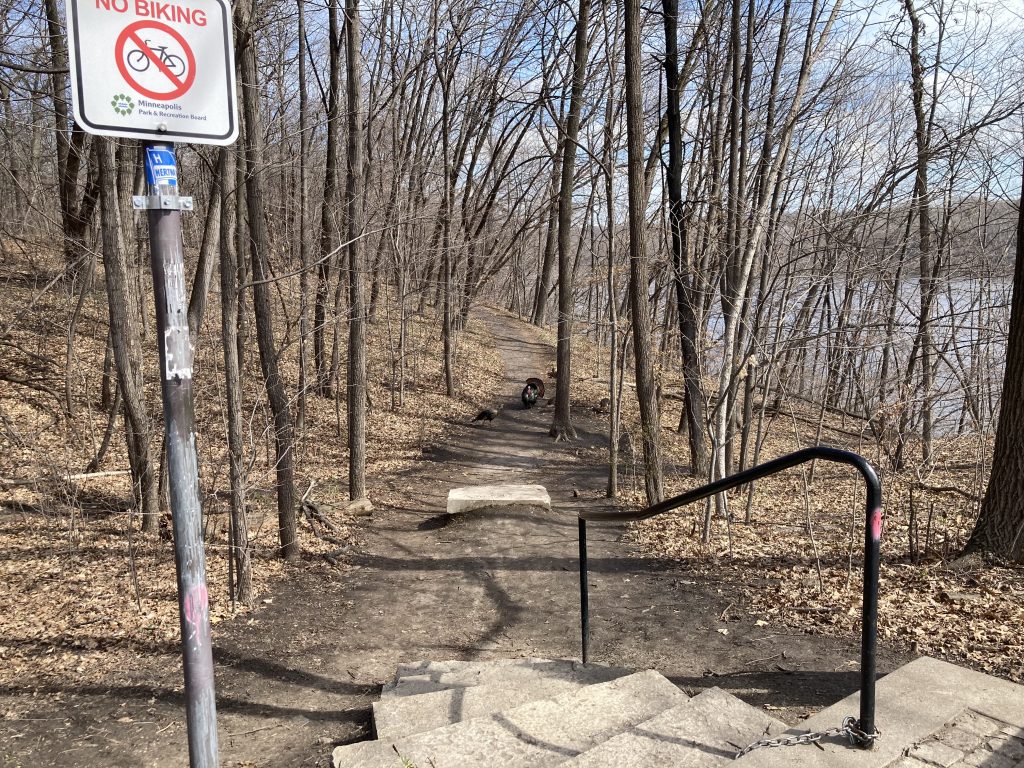4.9 miles
veterans’ bridge and back
36 degrees / snow flurries
wind: 16 mph / gusts: 31 mph
Windy, some snow flurries. They started when I started. At first, they looked like glitter falling from the sky, later they felt like sharp pins pricking my face. Difficult conditions, but I didn’t mind — well, not that much.
Saw a BIG turkey heading for the edge of the park. Also saw a bird — a robin, I think — running fast across the grass. It’s fun to watch birds run. Had a sudden thought: Where on the Beaufort Scale would you fit the description, birds opt for running instead of flying or flying is inconvenient for birds? In my head, I began composing lines for a poem that features this bird. Another description to add to the scale: a fallen leaf will outrun you — that’s not quite right, but something about how I noticed a leaf in front of me being pushed by the wind so fast that I couldn’t catch up to it.
Was too busy battling the wind to notice the river. I wonder, were there any foam or white horses on it?
Running south, I listened to the howling wind. Heading back north, I put in Taylor Swift’s new album: The Tortured Poet’s Department
Another 5 on the Beaufort Scale. As I ran I wondered about factors other than wind speed, like wind direction — head winds, tail winds, crosswinds. I never really thought about crosswinds before I started watching cycling races. Now, like many others, I look forward to windy days of a tour when there’s a chance that some bikers will get “caught out by the crosswinds” and the peloton will splinter.
Eula Biss, Pain Scale
Before moving onto level 2 on Biss’ pain scale, I’m trying to think more about 1 and what lines of poetry might fit it. Can’t find anything yet, but I’m imagining level 1 to be the type of pain so minor, so barely there, that we doubt its existence. If 0 is faith, then 1 is doubt.
2
The sensations of my own body may be the only subject on which I am qualified to claim expertise. Sad and terrible, then, how little I know. “How do you feel?” the doctor asks, and I cannot answer. Not accurately. “Does this hurt?” he asks. Again, I’m not sure. “Do you have more or less pain than the last time I saw you?” Hard to say. I begin to lie to protect my reputation. I try to act certain. Okay, so 2 is also doubt. That gray area when we’re not certain. I don’t mind not knowing, when knowing is not possible — embracing the mystery — but not being certain, not knowing when you feel like you should know, are supposed to know, is very difficult.
And here Biss introduces the Beaufort Scale!
Wind, like pain, is difficult to capture. The poor windsock is always striving, and always falling short. There’s the difficulty of describing, and there’s the difficulty of feeling, knowing, experiencing accurately . . .
It took sailors more than two hundred years to develop a standardized numerical scale for the measure of wind. The result, the Beaufort scale, provides twelve categories for everything from “Calm” to “Hurricane.” The scale offers not just a number, but a term for the wind, a range of speed, and a brief description. Creating a standard — a common language from which to communicate and connect with others, a scale that is practical
A force 2 wind on the Beaufort scale, for example, is a “Light Breeze” moving between four and seven miles per hour. On land, it is specified as “wind felt on face; leaves rustle; ordinary vanes moved by wind.”
3
Left alone in the exam room I stare at the pain scale, a simple number line complicated by only two phrases. Under zero: “no pain.” Under ten: “the worst pain imaginable.” Too much is contained between these numbers. . . . This idea of “the worst pain imaginable” produces anxiety. I don’t want to even imagine what the worst pain imaginable might be.
“Three is nothing,” my father tells me now. “Three is go home and take two aspirin.”
“You are not meant to be rating world suffering,” my friend in Honduras advises. “This scale applies only to you and your experience.” At first, this thought is tremendously relieving. It unburdens me of factoring the continent of Africa into my calculations. But the reality that my nerves alone feel my pain is terrifying. I hate the knowledge that I am isolated in this skin—alone with my pain and my own fallibility.
The more I read of Biss’ essay, the more I’m thinking about the purpose of these scales and what other purposes descriptions/words/language can offer. The wind scale is for utility: to help sailors estimate the wind speed using visual observations. The pain scale’s purpose: to better understand and care for patients.
4
conflating physical and emotion pain — is there actually a distinction? hurting vs. feeling?
pain as seen in a face — Biss wonders, no face, no pain? Then she describes how there are no visible markers of her pain — there was nothing to illustrate my pain except a number, which I was told to choose from between zero and ten. My proof. I’m thinking about how invisible my vision problem often is to others and also, how the doctors could tell immediately that something wasn’t right: I got a diagnosis. What relief! I’m also thinking of a New Yorker article I read recently about gaslighting that mentions how the gaslit crave a diagnosis because it offers irrefutable evidence of something being wrong.
Okay, more of the pain scale in the next entry. I’m thinking about a key distinction between the Beaufort and Pain scales: the Beaufort offers brief descriptions to accompany the numbers, not just the numbers.
And, returning to point of these scales: they’re practical, which would seem to make them, at least to some, not poetry. Poetry is impractical and about making strange what we thought was familiar. It removes the utility of language, making it delightfully useless. Of course many poets disagree with this simplistic assessment, myself included. One reason I’ve turned to poetry is because it is useful; it gives me language and a method for describing my strange ways of seeing to others.
I found the following poem in an entry from aug 1, 2019. I think the descriptions might offer a more compelling and practical way than numbers on a scale to understand what pain feels like.
Let us for a moment call this pain by other words/Dominik Parisien
Ask, How many roses does the hammer weigh
when it bears down on your skull?
Does the sword seem toothed like a toddler’s smile
or sharp as your first ice skates?
On a scale of anglerfish to northern lights
how bright are the flashes in your head?
When I touch this, here, which constellations
light the sky behind your eyes?
Would you say that pulsing is the flicker of a satellite
or the stubborn heartbeat of a newborn chick?
Ask, Can we for a moment make of beauty
the measure of our pain? and I will answer.


